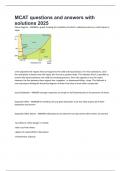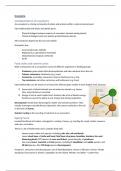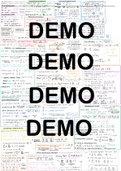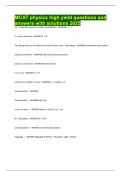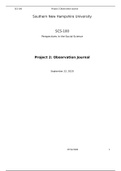solutions 2025
Phase Diagram - ANSWER a graph showing the conditions at which a substance exists as a solid, liquid, or
vapor
a line separates the regions that correspond to the solid and liquid phases. For most substances, since
the solid phase is denser than the liquid, this line has a positive slope. This indicates that it is possible to
convert the liquid substance into solid by increasing pressure. Since the opposite is true for water,
however, the line between these regions has a negative - or downward-tilting - slope. This hallmark is
one easy way to distinguish the phase diagram of water from that of most other compounds.
social facilitation - ANSWER stronger responses on simple or well-learned tasks in the presence of others
bystander effect - ANSWER the tendency for any given bystander to be less likely to give aid if other
bystanders are present
bystander effect factors - ANSWER individuals do not intervene to help victims when others are present
-less likely to notice danger in crowds
-take cues from others
-degree of responsibility is decreased
-cohesiveness of group
,Deindividuation - ANSWER when an individual seems to lose himself or herself in the group's identity
social loafing - ANSWER the tendency for people in a group to exert less effort when pooling their efforts
toward attaining a common goal than when individually accountable
group polarization - ANSWER the enhancement of a group's prevailing inclinations through discussion
within the group. doesn't have to be irrational.
normative social influence - ANSWER behavior that is motivated by the desire to gain social acceptance
and approval
informational social influence - ANSWER influence resulting from one's willingness to accept others'
opinions about reality
Groupthink - ANSWER the mode of thinking that occurs when the desire for harmony in a decision-
making group overrides a realistic appraisal of alternatives. leads to irrational decisions by a group.
characteristics of group think - ANSWER invulnerability, rationalization, lack of introspection,
stereotyping, pressure, lack of disagreement, self-deception, insularity
Irving Janis and groupthink - ANSWER members of a group are so driven to reach unanimous decisions
that they no longer truly evaluate the consequences of their decisions
occurs when the groups making decision are isolated and homogeneous, there is a lack of impartial
leadership inside or outside the gorup, when there is a high level of pressure for a decision to be made
Conformity - ANSWER when someone's behavior, beliefs, or thinking changes to line up with the
perspective of others
compliance - ANSWER when the person conforms but internally dissents
Conversion - ANSWER genuine change in someone's beliefs
,Asch Experiment - ANSWER experimented how people would rather conform than state their own
individual answer even though they know the group's answer is wrong, length of lines
compliance (requests) - ANSWER responses to requests from someone with no power to enforce that
request.
foot-in-the-door technique - ANSWER asking for a small commitment and, after gaining compliance,
asking for a bigger commitment
door-in-the-face technique - ANSWER asking for a large commitment and being refused and then asking
for a smaller commitment
low-ball technique - ANSWER persuasive technique in which the seller of a product starts by quoting a
low sales price and then mentions all of the add-on costs once the customer has agreed to purchase the
product
obidience - ANSWER changing one's behavior at the command of an authority figure
Milgram Experiment - ANSWER an experiment devised in 1961 by Stanley Milgram, a psychologist at Yale
University, to see how far ordinary people would go to obey a scientific authority figure with giving
electric shocks
Stanford Prison Experiment (Zimbardo) - ANSWER classic "experiment" where individuals were assigned
to be guards / prisoners. w/in days they took on their roles and went too far. Highly unethical
social norms - ANSWER rules, spoken or unspoken, that regulate behavior, beliefs, attitudes, and values
of members of society
social control - ANSWER the way norms are taught, enforced, and perpetuated
deviance - ANSWER when someone doesn't follow a norm
, formal vs informal norms - ANSWER Formal:
-generally written down, like *laws*
-precisely defined, publicly presented and have strict penalties for violators
informal: generally understood but less precise and carry no specific punishment
Folkways - ANSWER insignificant informal norms that involve small details, violating them does not cause
too much of a problem, example: fashion, wearing socks with sandals
mores - ANSWER informal norms, which incur severe disapproval when violated. ex: cheating on
romantic partner
taboos - ANSWER even more restrictive norms that generate extreme disapproval. Ex: cannabalism,
incest. Driven by culture. Some are forbidden by law and some aren't.
Anomie - ANSWER Refers to situation where there is a poor match between society's stated norms and
the norms that an individual responds to
sanctions - ANSWER punishment or negative consequences for violating a social norm. Rewards for
following social norm.
adding a solute to water will ----- bp and ----- mp, - ANSWER increase; lower
differential association theory - ANSWER theory that individuals learn deviance in proportion to number
of deviant acts they are exposed to, and deviance is learned socially, draws from symbolic interactionism
labeling approach - ANSWER focuses on how behavior is affected by being labeled as a deviant.
Primary Deviance (Labeling Theory) - ANSWER the initial act or attitude that causes one to be labeled
deviant

